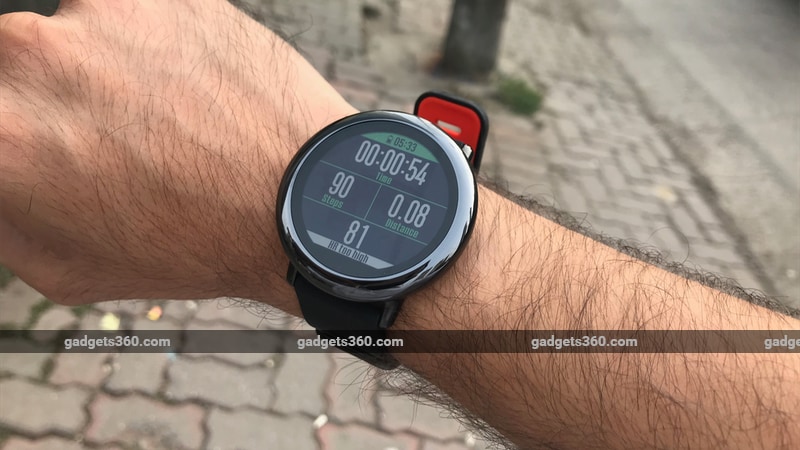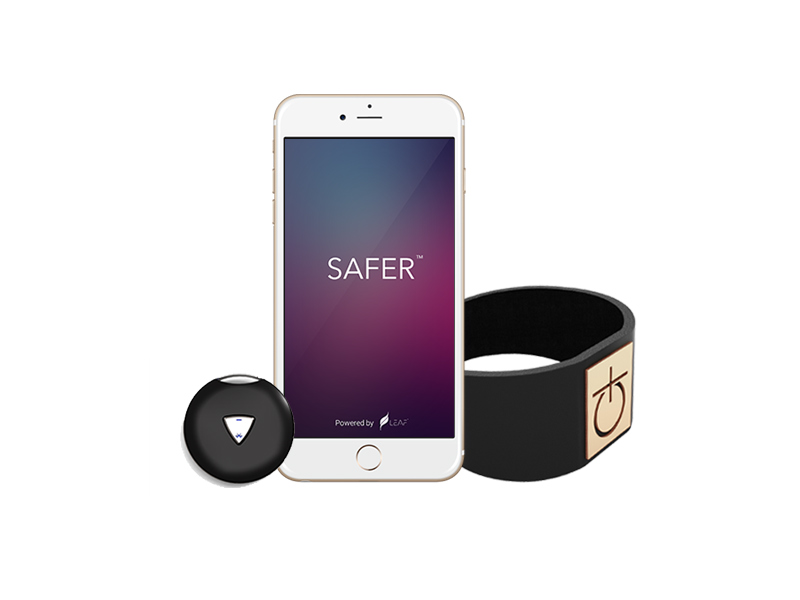The Amazfit Pace is a fitness oriented watch designed for runners. Amazfit is a brand owned by Huami, a company backed by the well-known tech brand Xiaomi. We reviewed the Amazfit Stratos a little while ago, which was a watch targeted specifically at triathletes, but had a number of problems. The Amazfit Pace is less expensive and lacks some of the features of the Stratos. This new model doesn’t support swim tracking, and it’s only IP67 rated for water and dust resistance. That means it’ll be fine if immersed up to 1m deep in water for a short time, which is not good enough for swimmers.
We like the design of the Amazfit Pace a lot more than we liked the Stratos. This watch is thinner, lighter, and looks a lot better thanks to the ceramic ring that surrounds its display. This fitness watch has only one button, with the rest of the interface relying on its touchscreen. The button doesn’t do much apart from unlocking the device and powering it on or off. The Amazfit Pace’s strap is made of a soft rubber-like material, similar to the one on the Stratos. This material is pretty comfortable to wear, but it left temporary marks on our skin because we like wearing watches tight.
The base of the Amazfit Pace has a heart rate sensor and contacts for charging. The Pace uses a proprietary charger which is different from the one used on the Amazfit Stratos. This fragmentation is something we’ve seen with Fitbit as well, and it’s sad that you can’t reuse chargers. Ideally, we’d want companies to be using one charger for all products, but that rarely happens in the wearables space. On the other hand, the custom charging plate has a Micro-USB port, so at least you can use common USB cables and wall adapters.
![]() Amazfit Pace has a clip-on charger
Amazfit Pace has a clip-on charger
The Amazfit Pace has a colour display, but that’s also the biggest weakness of this device. The backlight is just not bright enough to always be legible outdoors under harsh sunlight. Viewing angles are pretty bad too, which means that the display is best read by looking at it directly. If you view it at an angle, as is common for something you wear on your wrist, it’s not always going to be readable. We’re quite disappointed with this display, and we think that at this price point, there are other fitness watches that are easier to glance at, such as TomTom Spark 3. It would have been better to have a monochrome display that was easier to read.
The Amazfit Pace’s software is pretty much the same as that on the Stratos. It’s a proprietary OS designed by Huami, and we’re not big fans of the interface. There’s a very limited number of watch faces, which is a big disappointment. There are hardly any apps for the Amazfit Pace so basic features such as recording your workout data via a third-party app such as Strava or Nike+ Running isn’t straightforward.
The only app we found interesting was the Training Center app, which allows you to follow a plan and train for races. A lot of people only use wearables to track their runs and workouts, but if you have a proper training plan and want your watch to train you, this app does the job.
The smartwatch features of the Amazfit Pace are also quite limited. You can see notifications but not respond to them. This means that this wearable is much more of a fitness watch for runners, and notifications are a less important built-in feature.
The Amazfit Watch smartphone app looks slick, but it doesn’t do much. Most of the things you need to customise (such as 12- or 24-hour time display) can be done directly on the watch, and the only use for the app for us was to see check our run durations and heart rate stats. This brings us to the performance of the Amazfit Pace.
We used this watch for multiple runs, and two of these need to be brought to your attention. One was a 10km race at Mumbai’s Bandra-Kurla Complex area, which has wide roads by Mumbai standards and a lot of tall office buildings. We ran this race on a certified course, which means that it was measured and built to exacting standards. The Amazfit Pace, at the end of the run, said we’d run 10.07km. This is extremely accurate, and we saw similar results when running in open areas.
![]() Amazfit Pace’s charger uses a Micro-USB port
Amazfit Pace’s charger uses a Micro-USB port
However, the second run was on a 1km route near our office. This stretch has a flyover and lots of trees, and only the best GPS devices are able to track runs through this area properly. We used a car’s odometer to verify that the distance was 1km. At the end of the run, the Amazfit Pace showed that we’d run 1.24km. A 24 percent error in measurement is unacceptable. The best GPS-based run trackers will work reasonably well even when the conditions aren’t ideal, and unfortunately the Amazfit Pace is not one of them.
We also tested the step tracker on the Amazfit Pace with our standard 1,000-step test. Here we walk 1,000 steps while counting manually, and then check how the watch’s data compares. The Amazfit Pace showed that we’d walked 1,004 steps at the end of this test and that’s about as accurate as it gets.
The heart rate sensor on the Amazfit Pace was fairly accurate most of the time. We tested this by wearing the Amazfit Pace on our right hand and an Apple Watch Series 2 on our left. We also verified our data once using a finger pulse oximeter, which is used widely to check heart rate. When running, the Amazfit Pace was able to take pretty accurate measurements.
However, the watch does not have a dedicated strength training or gym mode for heart rate measurement. The best it does is “Indoor Walk / Run”, “Elliptical” or “Bike Indoors”. We used the last two for our strength training sessions thrice a week during the review period. It’s here that the Amazfit Pace failed completely. In those two modes, the heart rate displayed on the watch was much lower than our actual heart rate. In one session, we did 20 box jumps really quickly. Both the Apple Watch and the oximeter showed our heart rate as 183bpm, but the Amazfit Pace measured between 112bpm and 125bpm. Strength training is a big part of any runner’s life, and it’s sad to see that the Amazfit Pace isn’t equipped to track these sessions.
![]() Amazfit Pace has a single hardware button on the side
Amazfit Pace has a single hardware button on the side
The battery life of the Amazfit Pace was good. We managed to make the watch last around four days on a single charge. This included two indoor gym sessions and one run, with continuous heart rate monitoring enabled throughout, and also with our phone’s notifications enabled. We’d have been happier if the watch had been able to last through a full working week, but it’s only a minor inconvenience.
The Amazon-exclusive Amazfit Pace is priced at Rs. 9,999, but there is a catch. A couple of times that we checked, this watch was out of stock and only available from third-party sellers on Amazon, who were charging around Rs. 12,990 for it. The watch did come back in stock later but third-party sellers selling the device at higher prices is a concern. At its official price, the Amazfit Pace offers decent value, if you can live without a proper gym mode and GPS functionality that doesn’t work perfectly when conditions aren’t ideal. We think that products such as the TomTom Spark are better, but they cost a little more too.


